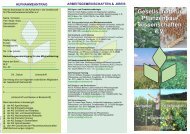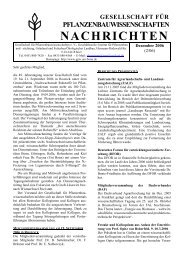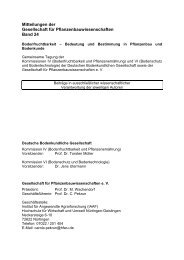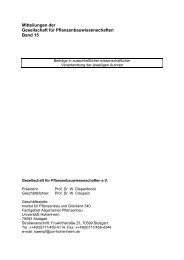Mitteilungen der Gesellschaft für Pflanzenbauwissenschaften Band 23
Mitteilungen der Gesellschaft für Pflanzenbauwissenschaften Band 23
Mitteilungen der Gesellschaft für Pflanzenbauwissenschaften Band 23
Erfolgreiche ePaper selbst erstellen
Machen Sie aus Ihren PDF Publikationen ein blätterbares Flipbook mit unserer einzigartigen Google optimierten e-Paper Software.
Mitt. Ges. Pflanzenbauwiss. <strong>23</strong>: 154 (2011)<br />
The role of phytohormons in the onset and development of leaf<br />
senescence un<strong>der</strong> nitrogen starvation in winter oilseed rape<br />
(Brassica napus L.) genotypes differing in nitrogen efficiency<br />
Fabian Köslin-Findeklee 1 , Sebastian Parra-Londono 1 , Gunda Schulte auf’m Erley 1 ,<br />
Thomas Roitsch 2 and Walter J. Horst 1<br />
1 Institute of Plant Nutrition, Gottfried Wilhelm Leibniz University Hannover; 2 Institute of Plant Sciences,<br />
Karl-Franzens-University, Graz, Österreich. E-Mail: koeslin-findeklee@pflern.uni-hannover.de<br />
Introduction<br />
Winter oilseed rape is the most important oil crop in European agriculture, but one<br />
with the highest nitrogen (N) balance surpluses. This may negatively impact the<br />
environment. N starvation induces leaf senescence. Phytohormons are involved in<br />
the onset and development of leaf senescence. Cytokinins and auxins are<br />
senescence-delaying; salicylic (SA) and jasmonic acid (JA) are senescenceenhancing<br />
(Lim et al. 2007). We hypothesized that delayed leaf senescence is<br />
beneficial to yield formation because of maintained photosynthesis into the<br />
reproductive growth stage (Wiesler et al. 2001). The aim of the study was to clarify if<br />
genotypic differences in leaf senescence un<strong>der</strong> N deficiency correspond to the effect<br />
of certain phytohormons.<br />
Material and Methods<br />
A time-course nutrient solution experiment was performed with two pairs of<br />
genotypes (NPZ-1: N-efficient & NPZ-2: N-inefficient / Apex: N-efficient & Capitol: Ninefficient)<br />
which differ in leaf senescence (stay green) and yield formation un<strong>der</strong> Nlimited<br />
conditions. The plants were grown after a four weeks pre-culture for another<br />
12 days un<strong>der</strong> different N levels (0.1 mM N and 4.0 mM N).<br />
Results and Discussion<br />
SPAD and photosynthesis rate were suitable for detecting genotypic differences in<br />
leaf senescence, but the photosynthesis rate was more sensitive. The expression<br />
profiles of selected senescence associated genes (quantitative Real Time- PCR) in<br />
senescing leaves also reflected genotypic differences in leaf senescence. Preliminary<br />
evaluation of the results revealed that N deficiency sensitively induced the transport<br />
of SA and JA transport from the roots to the shoots. Presently, an inventory of the<br />
pattern of the concentrations of phytohormones including SA and JA in roots, leaves<br />
and xylem exudates is in progress. To back up these results the expression of genes<br />
related to the metabolism of phytohormones using qRT-PCR is being analysed.<br />
References<br />
Lim, P.O., Kim, H.J., Nam, H.G. 2007: Leaf senescence. Annual Review of Plant Biology. 58:115-36.<br />
Wiesler, F., Behrens, T., Horst, W.J. 2001: Nitrogen efficiency of contrasting rape ideotypes. In: Horst,<br />
W.J. et al. (eds.) Plant nutrition – Food security and sustainability of agro-ecosystems. Dordrecht,<br />
Kluwer, 92:60-61.







